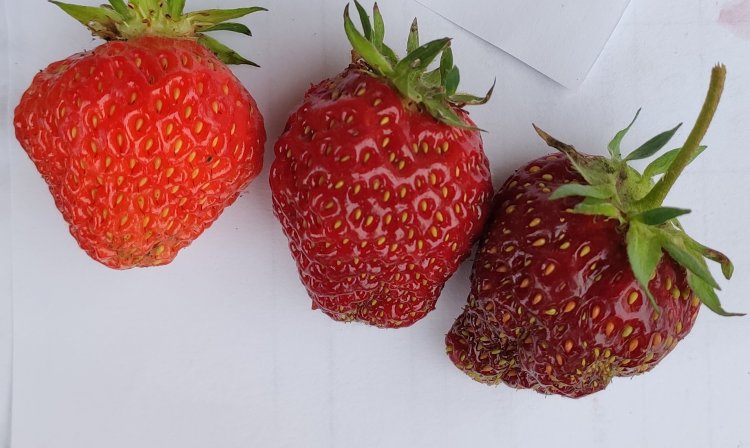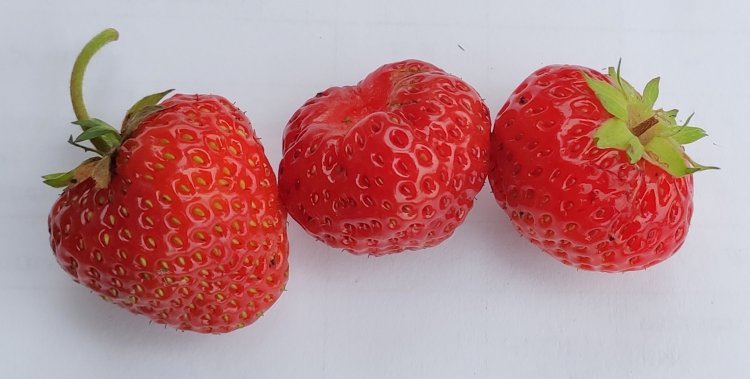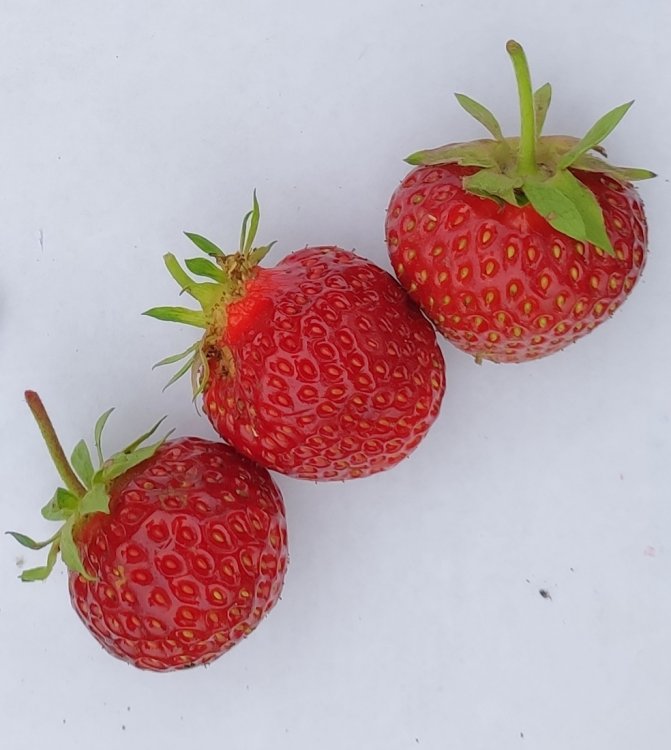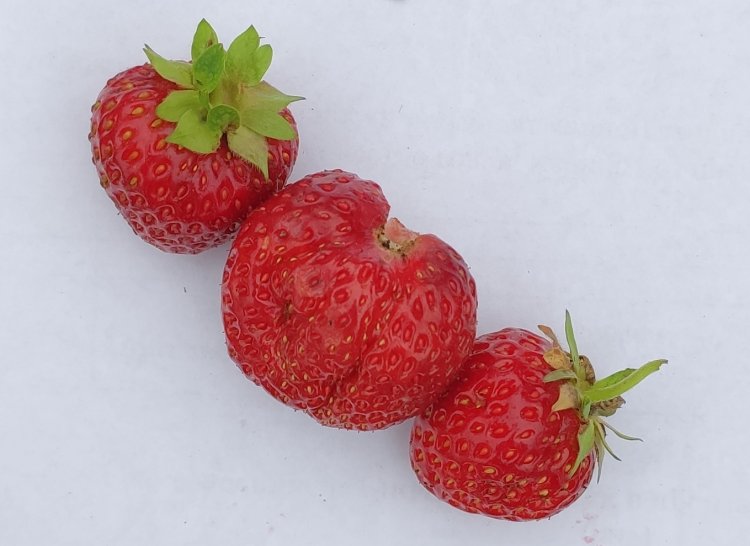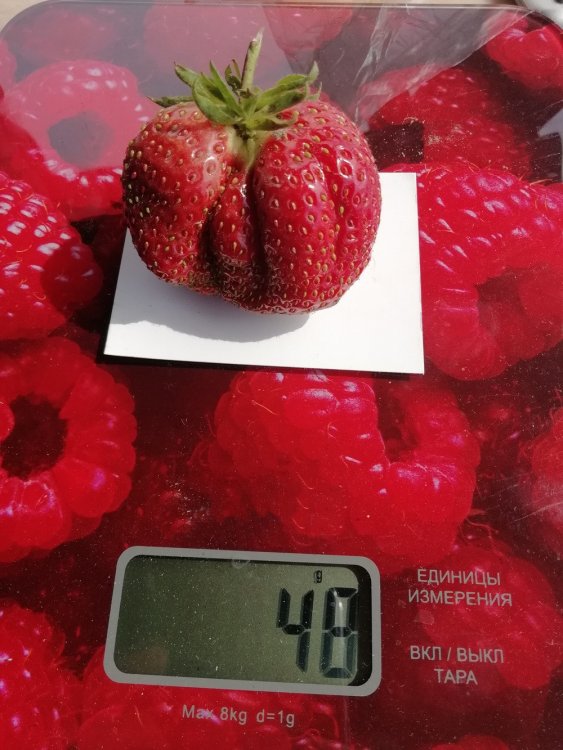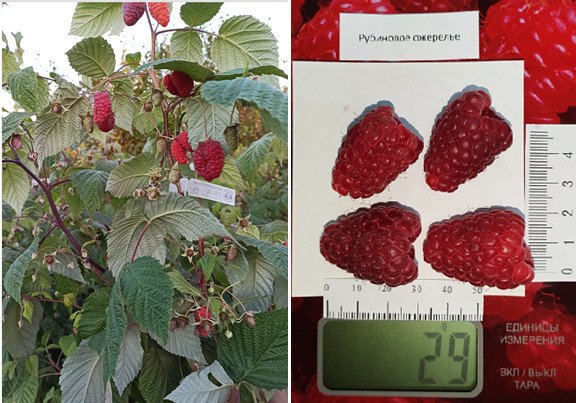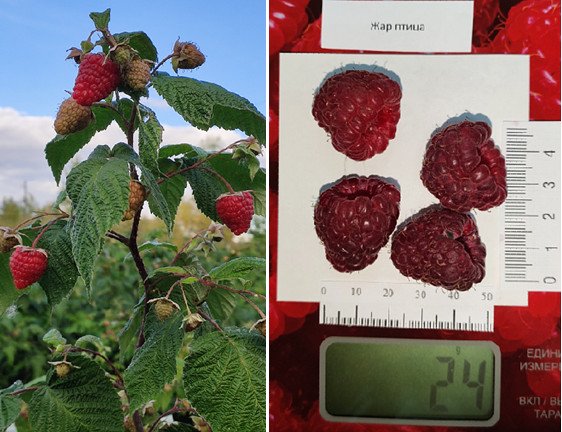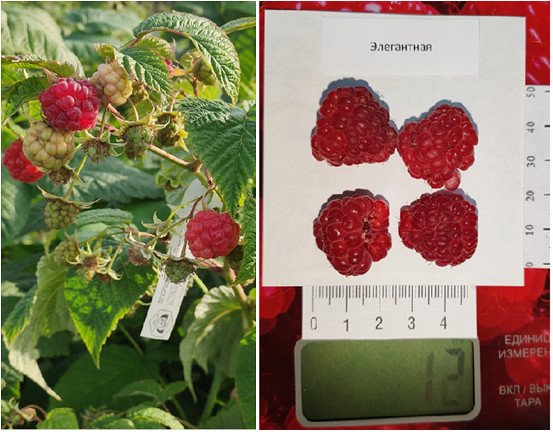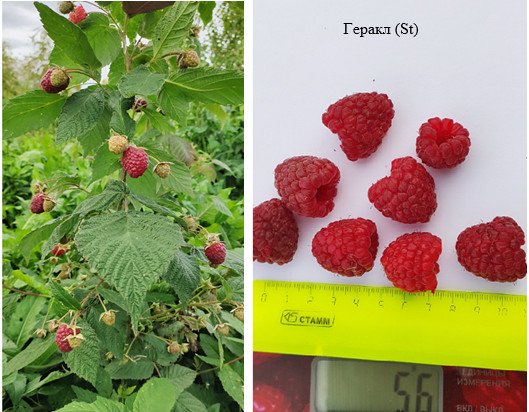Experts from the Federal Komi Research Center of the Urals Department of RAS (based in Syktyvkar) are studying and breeding promising and highly productive varieties of berry crops adapted to the climate of the North. Berry growing in the risky farming zone where the Komi Republic is located requires a special approach to growing frost-resistant varieties of strawberries and raspberries while preserving their attractive appearance and dessert taste.
Strawberries and raspberries are mainstay berry crops along with fruit-bearing and nut-bearing plants in the northern regions of our country. A combination of vitamins, oils, sugars and their uniquely tasting juicy, delicious flesh not only make them important and healthy foods but act to boost immunity.
Domestic researchers experimentally identify varieties of garden strawberries and remontant raspberries which are best adapted to the climate of the Komi Republic. Properly bred berry crops benefit from their resistance to diseases, large fertility, productivity and an excellent taste. The general state of strawberry and raspberry varieties is determined by assessing the plants during vegetation and at different maturation times in terms of the extent of damage by diseases and pests, bush loading in the previous season, taking into account the snow cover disappearance time and the duration of frosts. A review of findings on productivity enabled researchers to rank berry crop varieties and develop methodological recommendations for adaptation to the conditions of the North.
Associate fellow Yelena Vladimirovna Krasilnikova and research fellow Yelena Valeryevna Pavlova, experts from the Experimental Arboretum Laboratory of the A. V. Zhuravsky Agrobiotechnology Institute under the Komi Research Center of the Urals Department of RAS (based in Syktyvkar), have told us about studies and highlights of growing varieties of garden strawberries and remontant raspberries in the conditions of the Republic of Komi and noted which of them are in demand and popular with the consumers of the northern region.
As noted by Yelena Pavlova, “As far as berry growing is concerned, there are special considerations due to the short growing season, harsh winters and deceptive transition periods between seasons. Located at the northeast end of the European part of the Russian Federation, the Komi Republic is characterized by cold weather. For example, the period with daily mean air temperatures above 0°C is never longer than 150–197 days with the sum of above-freezing temperatures about 1250–2000°C. The frost-free period is 70–105 days long, and the repeatability of summertime frosts ranges 40–50%. A stable snow cover is formed between November 1st and 20th and persists until late April or early May. A feature of the climate is the frequent change of air masses associated with the passage of cyclones. Cyclonic activity is most developed in winter and autumn and gets weaker in the summer. When Arctic air intrudes in the winter, air temperature may drop to −48°C and even as low as −55°C. Intrusions of Arctic air in the warm season cause frosts that can occur throughout the summer (excluding areas in the south).”
Such weather and meteorological conditions of the Republic of Komi call for special considerations in the berry farming technology.
Yelena Pavlova cites an example for strawberries, “protective plantations or bands are of particular importance as they promote accumulation and uniform distribution of slow and safeguard the crops against prevalent northerly winds.” Smaller shrubs (currants, gooseberry, etc.) are usually planted at the edges of the plantation. They protect the crops from cold winds and contribute to snow retention. Strawberries are a heliophilous species and so must be planted in warmer spots where water and cold air do not persist for long and sunlight is abundant. Strawberry is not very demanding when it comes to soil but it grows best in moderately loamy soils. Before planting the soil is dug up to the spade’s depth after sprinkling it with organic and mineral fertilizer. Strawberry grown for fruit must be cared for by frequent weeding and tillage of soil within and between rows. Strawberries of all ages are very responsive to soil tilling in early spring.
Berries mature at different times depending on the place of cultivation and variety, this period lasts for 20-35 days. The best time to pick berries is in the morning. Berries must be harvested every 1-2 days to prevent them from overripening. After harvesting (in the second half of the summer), strawberries shoot new spurs, form new leaves, grow their roots intensively and produce new flower buds. The post-harvest period is important in the lifecycle of strawberries. Therefore, soil must be cultivated within and between rows immediately after the end of berry harvesting. After strawberries have completed fruit-bearing they begin to produce flagella and rosettes more intensively. Growing flagella must be cut off systematically as they weaken the mother plant, slow its growth, reduce frost resistance and yield.”
Raspberry is another heliophilous crop that prefers well-lit and wind-protected places. According to Yelena Krasilnikova, “for spring planting soil must be tilled and fertilized in the autumn of the previous year, while for summer and autumn planting this must be done a month before planting. Raspberry is usually planted in the spring before its buds open or in the autumn before frosts set in. There are 2 main raspberry planting arrangements: 1) banded (or stripped) and 2) clustered (across inter-row spaces depending on the variety). I would note that the banded layout of raspberry cultivation differs from the clustered by a number of advantages: it ensures higher yield and more durable plantations. Rows should be preferably oriented from north to south so they don’t cast shadows on each other.
Raspberry yield is largely dependent on soil care, as plants suffer greatly from soil compaction and lack of moisture. The root system of raspberries is confined to upper soil layers so frequent tilling, especially deep-penetrating, can damage the roots. Of great importance for raspberry is mulching with organic materials (such as peat, peat compost, humus and leaves).This agricultural technique not only improves the water, air, nutrient and temperature conditions of the soil but also prevents weed germination, obviating the need for treatment within rows. Raspberry is very responsive to fertilizer. Manure and compacted peat are best choice. It is necessary to fertilize raspberry annually. Two-year raspberry shoots die after bearing fruit and therefore must be cut off in a stump-free fashion after harvesting berries. All excess, weak, pest-infested or disease-affected shoots should be also removed at the same time. This procedure ensures better lighting and air conditions for the remaining shoots. When the clustered growing method is used, every raspberry bush must be kept down to 8-10 strongest, healthiest shoots. For the strip method, about 10-15 shoots should be left per 1 meter of row length.”
For the third season in row, researchers from the Experimental Arboretum Laboratory of the A. V. Zhuravsky Agrobiotechnology Institute under the Komi Research Center of the Urals Department of RAS are investigating the varieties of berries suitable for the harsh conditions of the Republic of Komi. Works is carried out in accordance with the Program and Method for Researching Varieties of Fruit, Berry and Nut Crops [Oryol: VNIISPK, 1999] and B.A. Dospekhov’s Field Experimentation Method [Moscow: Agropromizdat, 1985].
The planting stock of strawberries and raspberries comes from years-long partners, the Northeast Federal Agricultural Research Center, the Federal Horticulture Research Center and I.V. Michurin Federal Research Center. Field studies are carried out in the fruit and berry arboretum of the Agrobiotechnology Institute.
Studies of berry crops involve several stages. First, several observations are held: timing of phonological stages, growth strength, resistance to extreme environmental factors (low and high temperatures, lack or excess of moisture, pests and disease damage), productivity, commercial and taste qualities of fruits. Second, additional observations (technological, biochemical, adaptive) are carried out on the varieties standing out with a favorable combination of properties. The resulting data undergoes biometric processing and comprises a pomological snapshot of the variety.
According to Yelena Pavlova, “successful harvesting of stable crops in berry farming is contingent on the correct selection of varieties adaptable to low-temperature stresses and capable of maintaining high productivity along with resistance to pests and diseases. It is also important to take into account the dessert qualities of berries, the size of their fruit and maturation times.”
Yelena Pavlova, a specialist in strawberries, clarified that “recognized varieties are most adapted to growing conditions in our region while being able to maintain stable productivity in evolving weather conditions over different years. I would single out Zarya among early-ripening varieties and Festivalnaya among medium-ripening varieties.”
What varieties of strawberries have you studied and what are their beneficial economic and biological features?
“Between 1997 and 2020, fifty-seven varieties have been studied and assessed. High adaptive properties were shown by the varieties Urozhaynaya TsGL, Gornouktusskaya, Ruslan, Tsarskoselskaya, Unia Smides, Vityaz, Kokinskaya Zarya, Totem, Pervoklassnitsa, and Slavutych. Their average yield over the years of research ranged from 16.4 to 18.3 tons per hectare. The varieties have shown field resistance to major diseases and pests. The Pervoklassnitsa was notable for its moderate resistance to the damage of berries with grey rot. Judged as best-tasting were the varieties Gornouktusskaya, Tsarskoselskaya, Vityaz, Kokinskaya Zarya (4.8 to 5 points on a 5-point scale), and among recognized varieties, Zarya (4.5 to 4.8 points).
Kokinskaya Zarya variety. Winter-hardy. High-yielding at 16.46 t/ha with a maximum yield of 18.45 t/ha (corresponding to 1.65 and 1.85 kg/linear meter with a narrow-row layout spaced 1 m apart). Berries are large, dessert-tasting. The average weight of berries is 10.47 g with a maximum of 19.20 g. Nutrient content: 12.52% solids, 7.34% sugars, 549.1 ppm vitamin C, 1.35% acids.
Appearance of the Zarya garden variety strawberries.
Vityaz variety. Winter-hardy. Moderate-yielding at 14.70 t/ha with a maximum yield of 15.99 t/ha (corresponding to 1.47 and 1.60 kg/lin.m with a narrow-row layout spaced 1 m apart). Berries are large, with a refreshing sour-sweet taste. The average weight of berries is 10 .47 g with a maximum of 19.20 g. Nutrient content: 11.51% solids, 6.60% sugars, 556.2 ppm vitamin C, 1.47% acids.
Appearance of the Vityaz garden variety strawberries.
Totem variety. Winter-hardy. High-yielding at 18.30 t/ha with a maximum yield of 19.8 t/ha (corresponding to 1.83 and 1.89 kg/lin.m with a narrow-row layout spaced 1 m apart). Berries are large, dessert-tasting. The average weight of berries is 9.82 g with a maximum of 23.66 g. Nutrient content: 11.44 % solids, 5.94 % sugars, 464.4 ppm vitamin C, 1.31 % acids.
Appearance of the Totem garden variety strawberries.
Appearance of the Pervoklassnitsa garden variety strawberries.
Pervoklassnitsa variety. Winter-hardy. Moderate-yielding at 17.5 t/ha with a maximum yield of 19.0 t/ha (corresponding to 1.75 and 1.90 kg/lin.m with a narrow-row layout spaced 1 m apart). Berries are large, with a refreshing sour-sweet taste. The average weight of berries is 13.01 g with a maximum of 31.04 g. Nutrient content: 10.81 % solids, 5.72 % sugars, 365.2 ppm vitamin C, 1.42 % acids. Average damage with grey rot 25.82%, affliction with strawberry root weevils up to 1.5 points,” Yelena Pavlova recited the main properties of strawberry varieties such as their resistance to diseases, yield and taste.
The heaviest berry of the Pervoklassnitsa variety weighed 48 grams. The 2019 crop.
Yelena Krasilnikova studies raspberry varieties. As noted by the expert, “according to the results of studies held in 2005-2013, highly productive varieties of the common raspberry have been identified for the formation of adaptive raspberry agrophytocenoses in the conditions of the Komi Republic: Ottawa (2.70 kg/lin. m), Wrestler (2.86 kg/lin. m) which reliably exceeded the productivity of the best of the standards – the recognized variety Novost Kuzmina (1.53 kg/linear meter).
Proposed for planting at farmsteads, private farms and collective gardens are raspberry varieties whose productivity is on the level of the standard recognized variety, Novost Kuzmina, with different maturing times: early-ripening varieties of Gusar (1.88 kg/lin.m), Kolokolchik (2.13 kg); medium-ripening varieties of Zorenka Altaya (1.72 kg), Sokolyonok (1.72 kg); and late-ripening varieties of Samarskaya Plotnaya (2.02 kg), Peresvet (1.96 kg).”
What is the cause of interest in remontant forms of raspberry?
“Regarding remontant raspberry, in recent decades there has been a significant increase in interest in varieties of this type. This is because they can bear fruit on one-year shoots at a later date than the common raspberry varieties. While being unable compete with common varieties, remontant raspberry is rather is demanded as an independent crop allowing to extend the period of consumption of fresh berries up to 1.5-2 months on average. The growing area of remontant raspberry is constrained by a minimum frost-free period of 130 days and active temperature sum of 1800…2000°C. A low-cost, environmentally safe technology is used for growing remontant raspberries. The essence of it is that after harvesting and onset of stable autumn freezes the above-ground part of plants is mowed off or cut with pruning shears. Once stems are cut and removed from the site, most pests and diseases are also taken away and destroyed – in contrast, they would survive the winter on above-ground part of plants on ordinary varieties of raspberry. This means that remontant raspberry can be grown without protective chemicals, making it attractive in environmental and technical sense. The cultivation of remontant varieties of raspberry with the process similar to the one used for annual plants obviates the problem of winter resistance of stems, highly relevant for the conditions of Northwest Russia,” said Yelena Krasilnikova.
What varieties of remontant strawberries have you studied and what are their beneficial economic and biological features?
“For the first time in the conditions of the Republic of Komi, a collection of remontant raspberry varieties was assessed in terms of a combination of key economic and utility features and most promising varieties for establishing agrophytocenoses resistant to the action of biotic and abiotic stressors have been identified. Planting of a collection arboretum of remontant raspberry forms began in 2018, represented by 5 varieties: Rubinovoye Ozherelye, Zhar-Ptitsa, Elegantnaya, Oranzhevoye Chudo, Gerakl (St). All varieties are entered in the State Register of Selection Achievements of the Russian Federation", the expert said.
As Yelena Krasilnikova stressed, “collection studies of raspberry were performed under a reduced program on a smaller number of plants of each variety. The goal of collection studies is to provide rapid preliminary assessment of varieties so that some of them could be selected for the primary study. Observations were performed considering economic and biological features of remontant raspberry varieties such as sprout formation ability, general condition of plants, degree of resistance to existing diseases and pests, degree of thorniness, productivity, biochemical composition and commercial and consumer qualities of fruits.”
What is the actual and potential productivity of remontant raspberry varieties and what are the contributing factors?
“Productivity is determined by the genotype of the variety. Virtually every year limiting factors of vegetation and wintering come into play. Varieties with higher potential productivities are more sensitive to environmental stresses, they have a large amplitude of yield variability in harsh environmental conditions. The potential productivity of a single remontant raspberry plant was determined by multiplying generative formations on a single stem (buds, flowers, berries) by the average weight of berries and by the number of shoots in the bush. To estimate the actual productivity, the weight of mature berries per linear meter prior the advent of autumn frosts was considered", the researcher said.
Based on integrated of economically relevant properties, in particular criteria such as the content of sugars and solids, productivity, fruit size, taste and commercial/consumer qualities, the following varieties stand out, according to Yelena Krasilnikova:
Rubinovoye Ozherelye. Spreading bushes 120-145 cm high. It forms 7 basal shoots on average with numerous spears. Shoots are dense-thorned. Berries are very large (average weight 6.50 g, maximum weight 8.42 g), of elongated cylindrical shape, with a bright ruby color. The taste is sour-sweet, refreshing. Productivity is high at 0.59 kg/lin. m (3.9 t/ha), with 22.1% of potential productivity realized before autumn frosts. Berries begin to ripen in late August (21st to 30th). Resistant to disease and pest damage.
The Rubinovoye Ozherelye variety.Bush appearance (left), berry weight (g) and dimensions (cm) (right).
Zhar-Ptitsa. 130-150 cm high bushes, loosely spreading, forms 3-7 basal shoots and 8 to 20 spears. Shoots are dense-thorned. Berries are very large (average weight 6.60 g, maximum weight 9.29 g), conically shaped and bright red colored. The fruit tastes sour-sweet, dessert, with a pronounced aroma. Productivity stands at 0.55 kg/lin. m (3.6 t/ha), with 29.8% of potential productivity realized. Berries begin to ripen in early September. Resistant to disease and pest damage.
Zhar-Ptitsa variety. Bush appearance (left), berry weight (g) and dimensions (cm) (right).
Elegantnaya. 110-130 cm high bushes, spreading, forming 3 to 4 basal shoots and 6 to 17 spears. Rare thorns. Berries (average weight 3.08 g, maximum weight 3.53 g) are rounded, crimson-colored, sour-sweet tasting. Productivity stands at 0.37 kg/lin. m (2.4 t/ha), with 32.8 % of potential productivity realized in the conditions of the Komi Republic. Berries begin to ripen in the first third of September.
Oranzhevoye Chudo. The bush is 150-180 cm high, forms 3 to 4 basal shoots and 9 to 18 root spears. Rare-thorned variety. Berries are large (average weight 5.75 g, maximum 6.63 g), of elongated blunt conical shape, bright orange in color, with a sour-sweet dessert taste and a “raspberry-like” aroma. The productivity is 0.43 kg/lin. m (2.8 t/ha). The potential yield of the variety is realized in the conditions of the Komi Republic by 21.5%. Berries begin to ripen in late August (the final third of the month). Shoots can be severely afflicted by Didymella (4 points) and berries are vulnerable to grey rot.
Elegantnaya variety. Bush appearance (left), berry weight (g) and dimensions (cm) (right).
Oranzhevoye Chudo variety. Bush appearance (left), berry weight (g) and dimensions (cm) (right).
Gerakl. Forms few basal shoots, averaging 3 to 4 shoots per bush, grows up to 1.5 m high. A thorny variety. Berries are very large (average weight 6 to 7 g, maximum weight 9 g), of truncated conical shape, dark crimson colored, tasting sour-sweet. Productivity stands at 0.56 kg/lin. m (3.7 t/ha), with 18.4 % of potential productivity realized. Berries begin to ripen in early September. Resistant to disease and pest damage.”
Gerakl variety. Bush appearance (left), berry weight (g) and dimensions (cm) (right).
There are 92.7 thousand private farms (covering an area of 17.4 thousand hectares) and 76.4 thousand garden plots (covering an area of 10.1 thousand hectares) in the Republic of Komi, thus the results of research by the staff of the A. V. Zhuravsky Agrobiotechnology Institute under the Komi Research Center of the Urals Department of RAS find application in farmsteads and personal farms, collective gardens, in addition to being used in the educational process in federal state-funded institutions of higher education.
What kind of raspberry and strawberry varieties do you recommend for cultivation in the northern regions of the Russian Federation? How demanding they are when it comes to care?
“With properly chosen varieties, garden owners in the northern climate will be able, at minimum expense, to reap the maximum possible, stable, guaranteed and environmentally friendly harvest of berries for fresh consumption over a long time, also giving them extra time for processing the harvest.
When it comes to planting garden strawberry, our recommended varieties are Festivalnaya, Vityaz, Kokinskaya Zarya, Totem, and Pervoklassnitsa.
As for remontant raspberry, it is still too early to recommend any of the reported varieties as they are still under investigation. However, our preliminary findings show Rubinovoye Ozherelye, Zhar-Ptitsa, and Gerakl to be good performers”, the staff of the Experimental Arboretum Laboratory responded.
Which varieties of raspberry and strawberries are recognized as the most delicious and best-tasting?
“In terms of taste qualities, among the varieties of garden strawberry studied by us we would mention Zarya, Yemelya, Gornouktusskaya, and Kokinskaya Zarya.
Among the varieties of common raspberry, these are Novost Kuzmina, Gusar, Nagrada, Volnitsa, Ottawa, Zorenka Altaya, Shosha, Kirzhach, Rubin Bryansky, Samarskaya Plotnaya, Peresvet; and remontant varieties: Rubinovoye Ozherelye and Elegantnaya,” said Yelena Pavlova and Yelena Krasilnikova.
Which are the most suitable varieties for canning and which ones are better eaten fresh?
“Denser berries with higher content of solids are better for processing. Of these mentioned by us, the varieties Totem, Pervoklassnitsa, Tsarskoselskaya, and Kokinskaya Zarya are suitable.
Berries of remontant raspberry varieties are suitable for consumption both in fresh form and for all types of processing,” the experts advise.
Do you offer berry crops (for planting) on the retail/wholesale market? Are there already consumer reviews of these varieties? Which class does the buyer prefer?
“Yes, we offer limited quantities as soon as we propagate them. All characteristics of the variety are important to the customer: winter hardiness, productivity, quality and taste of berries, resistance to diseases and pests. Maturation times and the intensity of the variety are also taken into account. Varieties with high potential productivity should be chosen when conditions are favorable (water availability and the required sum of temperatures, rich soils). For unfavorable conditions, resistance to abiotic stresses confers advantage. Under unfavorable environmental conditions, the ecological stability of varieties contributes to the realization of their potential productivity. A collection of varieties with different properties will provide an annual guaranteed supply of berry products, so we offer varieties in view of their complementary qualities,” says Yelena Pavlova.
What is the forecast of this year’s berry crop harvest in your region?
“The early, unseasonably warm spring created the prerequisites for an early vegetation season. At the same time, not all varieties had wintered safely, and those that were the first to be cleaned from damaged last year’s leaves were exposed to cold nights, and the soil had not yet warmed up. In addition, low precipitation in May affected plant development, so despite high daily temperatures, strawberry plants had little success in expanding their leaves. Some varieties went on to bloom early – their first flowers were hit by recurrent frosts. Of course, such weather cataclysms do not contribute to a bumper crop.
Recurrent frosts also damaged the tops of the sprouts of the remontant raspberry, some of them had not yet topped and some were killed altogether. We can only expect to maximize our harvest when we have ensured the necessary level of all factors of life. Therefore, it is important to select varieties with a high adaptive capacity,” Yelena Pavlova told.
Thus, the varieties of berry crops studied by experts of the Federal Komi Research Center of the Urals Department of RAS confirm the ability to form adaptive properties and greater potential productivity in unfavorable conditions of the natural environment without sacrificing their unique taste properties.
All photos and pictures are provided by Yelena Pavlova and Yelena Krasilnikova
Photo preview Maria Volosina
